Mammoth Cave Wonders, Pictured Rocks Treasures, and Glass Connections
Please note that this site's Portfolio contains additional images of and details about the Mammoth Cave National Park books and the Pictured Rocks National Lakeshore ones described here.
A Cabinet of Mammoth Cave Wonders:
A Set of Five Artist’s Books Created for Mammoth Cave National Park by Sharon A. Sharp, 2009 Artist-in-Residence
From my Boone, North Carolina, home, I drove a winding route to the Mammoth Cave National Park realm of incomprehensible complexity—south-central Kentucky’s sinkhole-pocked karst landscape and the labyrinthine, multilevel system of cave passages it harbors. During my October stay I participated in ten cave tours and spent a total of about twenty-six hours in the cave, yet I still saw only a minute portion of this cave system—the longest known one in the world, at almost 400 miles and counting.
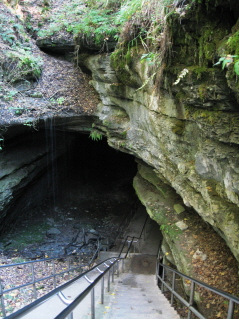
A lifelong rockhound, I relished learning about Mammoth Cave’s multi-million-year-old layers, its relation to the Green River’s carving power, and the “roof” of protective rock that keeps the cave dry and allows vast chambers to form. I also came to appreciate the bats, eyeless fish, and other creatures uniquely adapted to the cave, and I enjoyed hiking many of the park’s trails, which led me by springs and sinkholes, sycamores and pawpaws, turkey and deer.
I learned, too, about humans’ more than 3,500 years of connection to this place, from the native peoples who once sought gypsum to the Cave Research Foundation members who are still finding cave passages. The legacies of enslaved African Americans who became world-famous cave guides especially intrigued me, as did the contributions of other early mapmaker-explorers who painstakingly recorded complex routes and a plethora of place-names.
Day by day, my interest grew in creating a set of artist’s books, rather than a single book, to celebrate this complex environment and its history. While at the park, I did extensive journal writing, sketching, and photographing as groundwork for the books. Soon after returning home, I completed a project separate from the planned set—a large “star-tunnel” book for the December Cave Sing celebration, an annual tradition in which visitors decorate a cedar tree and sing carols inside the cave. Descriptions and photos of that book appear at the end of this page.
For the set, I wanted to portray cave and park features through varied book forms and a range of topics. The title, A Cabinet of Mammoth Cave Wonders, came to mind for several reasons. The word cabinet is part of two place-names in the cave (honoring renowned 19th-century scientists), and it reflects centuries-old traditions of keeping room- or case-sized collections of specimens and objects, referred to as wonders or curiosities, before the rise of modern natural history museums. My books became explorations of selected marvels from this cave and park. To house this collection, I created a compartment for each book inside a purchased, archival, black-cloth-covered storage box, which also displays the set’s title.
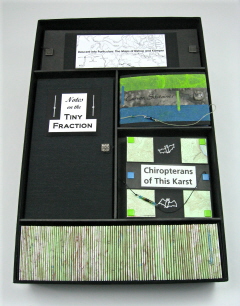
The set includes the following books, and more images of each one appear in the Portfolio, under National Parks Books:
Beyond Compare—a 96-signature, soft-cover, sewn-binding book that moves like a Slinky toy and incorporates extensive painting and handwritten facts about the cave, as well as a complete wall-sized U.S. Geological Survey topographic map of MCNP cut into the book’s 3” x 3” format (22″ long when fully extended)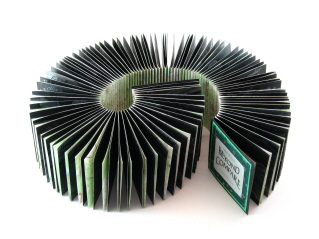 Carver, Sustainer—a 9-signature, soft-cover, Coptic-stitched book about water’s effects on the park’s karst landscape and on cave formation, as depicted through laser-printed text on clear acetate pages encased in multicolored-paper pages with hand-torn designs (5 1/2″ wide x 3 3/4″ high x 1 1/16″ deep)
Carver, Sustainer—a 9-signature, soft-cover, Coptic-stitched book about water’s effects on the park’s karst landscape and on cave formation, as depicted through laser-printed text on clear acetate pages encased in multicolored-paper pages with hand-torn designs (5 1/2″ wide x 3 3/4″ high x 1 1/16″ deep)
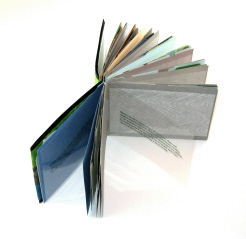
Chiropterans of This Karst—a 9-section, origami-style, multifold book about the park’s bat population that incorporates extensive drawings and handwritten facts, plus sections from another USGS topographic map of the park (5″ wide x 5″ high x 1 1/8″ deep; fully opened—forms a multi-angled circle 11 1/2″ in diameter)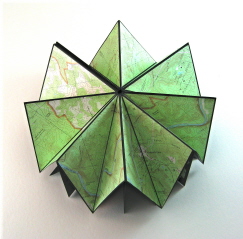
Descent into Particulars: The Maps of Bishop and Kämper—a 14-page accordion-style hard-cover book with clear acetate pages that contain laser-printed information about the explorers and mapmakers Stephen Bishop, Max Kämper, and Ed Bishop, along with their photos, the place-names from their maps, and portions of their maps (closed—11 1/2″ wide x 3 7/8″ high x 13/16″ deep; opened fully—approximately 45″, with less extension providing different multilayered views)
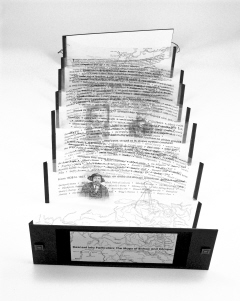
Notes on the Tiny Fraction—a hard-cover book with a collapsible “fishbone-fold” interior that depicts the tour routes in relation to the cave’s currently known length, represented through paintings and extensive handwritten notes about the cave and my tour experiences (5 1/4″ wide x 9 1/4″ high x 3/8″ deep; opened fully—approx. 24″ long)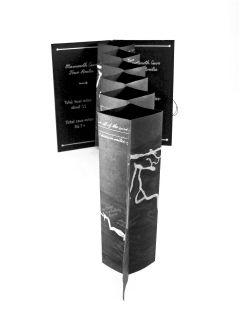
To offer the park rangers a first look at the set, I displayed the books in a Visitors Center conference room and answered questions about the bookmaking process. I hope that in future displays at the park, these books, as part of the interpretive programs and archives, may nurture appreciation of this vast, mysterious, essential part of our daily world.
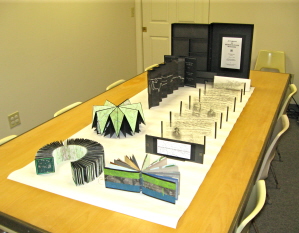
The residency experiences gave me an inexhaustible store of book-art ideas and a certainty that Mammoth Cave’s wonders are indeed boundless. I deeply appreciate the support of Ranger Eddie Wells and all of the other MCNP staff members who so generously encouraged my work, and I thank the National Park Service for its visionary partnerships with artists.
As noted above, I also completed an artist’s book for the park’s celebration of the holiday tradition known as Cave Sing. On December 5, 2009, people gathered at Mammoth Cave’s Historic Entrance and retraced the steps of a group who, in 1883, had carried a ten-foot cedar into the so-called Methodist church area of the cave (where a congregation once met), decorated the tree with ribbons and popcorn strings, and merrily sung carols. Cave Sing: Mammoth Cave National Park is a “star tunnel” book—that is, a book in which four multilayered tunnel sections are connected so that the book, when fully opened, forms a star. The book’s imagery and words center on 19th-century customs, and each tunnel section contains layers with silhouettes, historical facts and quotes, and collages with many different papers. When opened into the star, Cave Sing is 12″ high and 18″ from one star point to another. Here are two views:
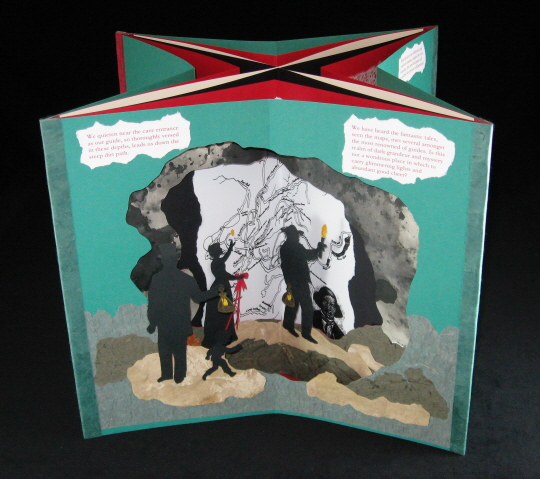
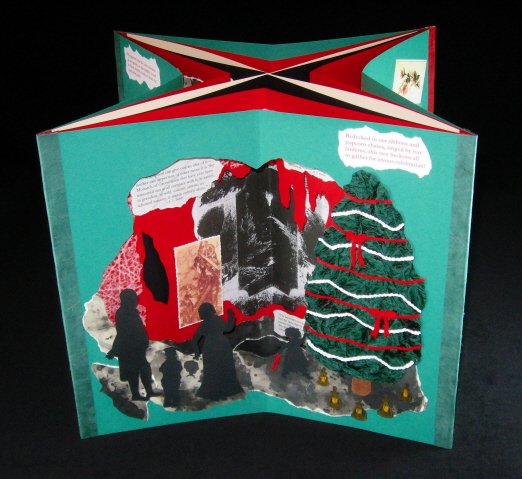
Every step in the process of creating this book pulled me more deeply into Mammoth Cave’s rich history. So many more stories, facts, and imaginings to be explored . . .
A wealth of information about this park—a national and world treasure—appears on Mammoth Cave National Park‘s website. Fortunately, my stay at the park coincided with the airing of Ken Burns’s beautiful series The National Parks: America’s Best Idea (which at least gave a nod to MCNP’s history); Kentucky Educational Television’s broadcast of the fascinating documentary Mammoth Cave: A Way to Wonder; and the release of Grand, Gloomy and Peculiar: Stephen Bishop at Mammoth Cave, Roger Brucker’s absorbing historical novel (which reflects the author’s experiences as a renowned cave explorer) about the 19th-century African American who, while enslaved, gained international fame as a Mammoth Cave guide and explorer. Also, just after I returned home, an interview with Ranger Jerry Bransford—the great-great-grandson of legendary guide and explorer Mat Bransford, also enslaved and a contemporary of Bishop—appeared in American Profile. All of these factors, combined with my park adventures, deepened my sense of having had an immersion experience that will inform my bookmaking for years to come!
Thanks to the park experience, I also gained an even deeper appreciation for the remarkable, award-winning poetry collection Ultima Thule, by former MCNP ranger Davis McCombs. In addition, I joined the National Speleological Society and learned about its wide range of research, education, and conservation activities, as well as the activities of its speleoartist members. Now, I look forward to supporting Mammoth Cave National Park’s unique role in educating the public about fragile, complex cave environments and their broad ecological significance.
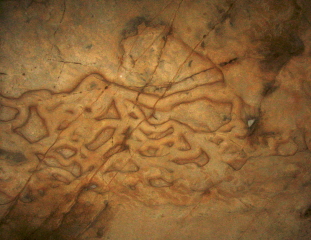
In the summer of 2010, I drew again on information gleaned from my Mammoth Cave experiences when I created two books about bats for submission to the National Speleological Society’s Fine Arts Salon exhibition, at the NSS annual convention. How Bat Entered English deals with how the word bat entered the English language, and I used a “flutter book” structure (developed by master book artist Hedi Kyle) because it fit with early references to a bat as a “flutter mouse.”
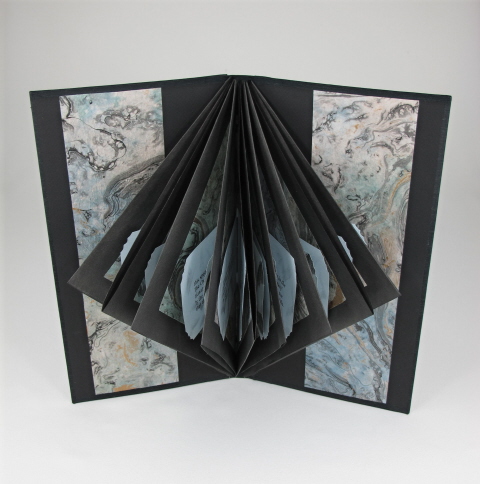
Great Good/Bad Fortune portrays the sharp contrast between Eastern and Western views of bats, 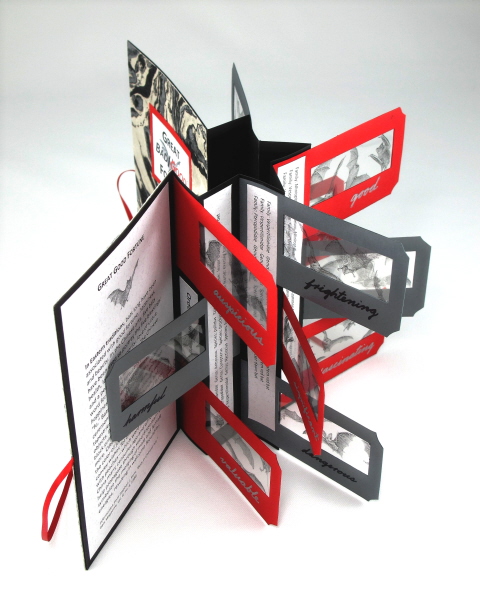 and I used both text and colors to highlight the differences. The movement inherent in this “flag book” form (also originated by Hedi Kyle) provides a sense of the bats being in flight.
and I used both text and colors to highlight the differences. The movement inherent in this “flag book” form (also originated by Hedi Kyle) provides a sense of the bats being in flight.
(This book and How Bat Entered English are represented by Vamp and Tramp Booksellers.)
Mammoth Cave history rushed to mind again when I received an invitation to submit a book for the May 27-July 31, 2011, exhibition "A Celebration of the Book" at the University of South Carolina's McMaster Gallery. The exhibition, co-hosted by the gallery and the Southeast Association for Book Arts, included works by 43 book artists from many parts of the United States. I returned to one facet of Mammoth Cave history that has most captivated me, as reflected in the title of my new book--Depth Perception: Mapmaking Legacies at Mammoth Cave. 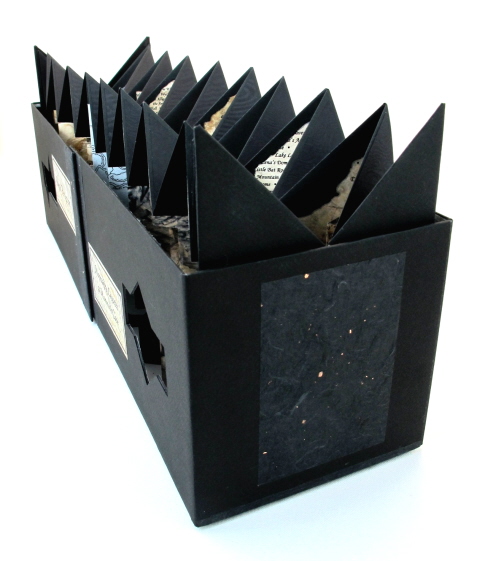
Through a complex book structure, cave-interior photos, and text, I examined the remarkable accomplishments of 19th-century and early-20th-century explorer-mapmakers Stephen Bishop and Max Kaemper, as well as the astounding physical characteristics of Mammoth Cave. Other images and descriptions of Depth Perception appear on the News and Portfolio--Selected Artist's Books parts of this website.
More than any of my previous books about Mammoth Cave, this one reinforced the fact that I have an inexhaustible source of ideas for future projects!

Pictured Rocks National Lakeshore, 2006 Joint Artists’ Residency
This Stretch of Riches
A Set of Seven Books Created for Pictured Rocks National Lakeshore by Sharon A. Sharp and Lucia Harrison, 2006 Artists-in-Residence
In the early fall of 2006, I flew to Michigan to meet my friend and book-arts collaborator Lucia Harrison (of Olympia, Washington), so we could begin our joint artists’ residency at Pictured Rocks National Lakeshore. We had met several years earlier at Penland School of Crafts and collaborated long-distance on some projects, but this was our first onsite collaborative venture. We were especially excited about getting to work creatively in a national park. 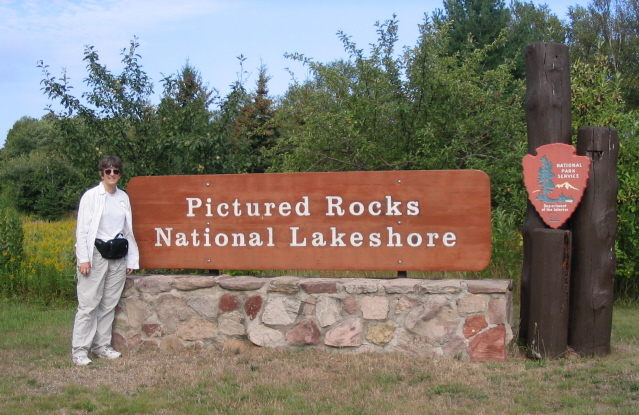
For almost three weeks we lived in the historic Coast Guard Station at Grand Marais, where spectacular sunsets and sunrises often framed our days and lured us to Lake Superior’s stone-strewn beaches. We pored over maps and field guides before, during, and after our hikes and drives throughout the park’s long, narrow expanse. New to the Upper Peninsula, we were captivated by patterns in the park’s diverse habitats—its forests, dunes, wetlands, streams, waterfalls, lakes, beaches, and windswept cliffs. We took photographs and made extensive notes on those, and we wrote and sketched in journals. As we learned to identify native flora and fauna, our amazement grew at the variety of species that have adapted so well to the harsh conditions along Lake Superior. On a cruise near dusk, we saw how the lake has relentlessly carved the multihued Pictured Rocks cliffs, and as the cliffs’ glowing russets danced across the lake’s brilliant blue surface, we understood even more fully why this area had been set aside as the first national lakeshore.
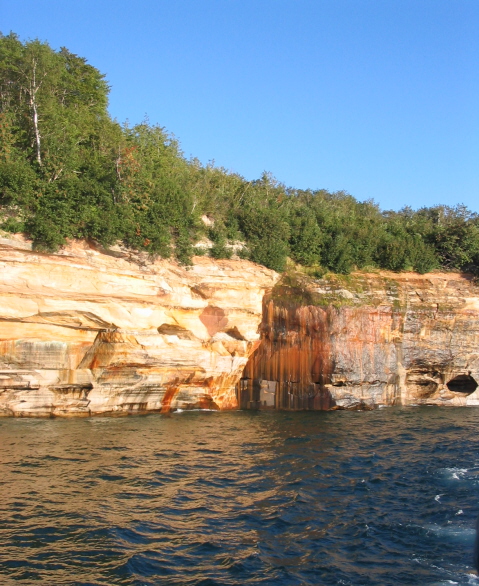
As our explorations broadened, we began envisioning a set of books that would reflect the complexity and richness surrounding us. The park’s unique shape and astounding diversity, along with the winding routes for our hikes, inspired us to plan the long, stretched, undulating form of the Slinky-type book, All in Stride. We created more than forty original pieces of artwork, which were then converted into the archival inkjet prints filling All in Stride and forming the covers of the accompanying haiku books. In that collection of small books, our observations and musings fan out in accordion forms. We wanted each book and the set as a whole to convey a sense of unfolding, as with the park’s cycles of change and with our own growing appreciation. For This Stretch of Riches, we each created half of the artwork, Lucia scanned and printed the pages and crafted the box, and Sharon wrote the haiku and stitched the larger book.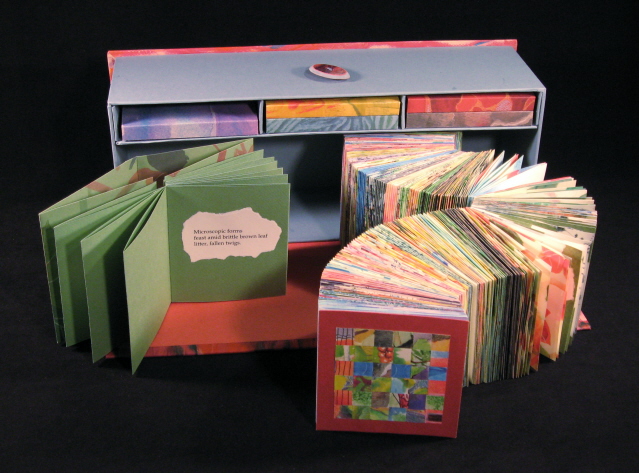
Throughout our stay we were welcomed and looked after by park employees, park volunteers, and local schoolteachers. We remain deeply grateful to the PRNL staff and the National Park Service for the rare opportunity we had to explore this realm and share our impressions of its abundant beauty.
The preceding description varies slightly from the artists’ statement we included with the set, which was donated to the park for visitors’ enjoyment.
To learn more about Lucia Harrison’s artist’s books, paintings, and teaching activities, visit Lucia’s website, luciaharrison.com, and the Evergreen State College website. Throughout her work, Lucia has focused on ecological issues in multifaceted, intuitive, insightful ways. Our PRNL collaboration deepened my appreciation for her remarkable talents and her great generosity as a friend and colleague.
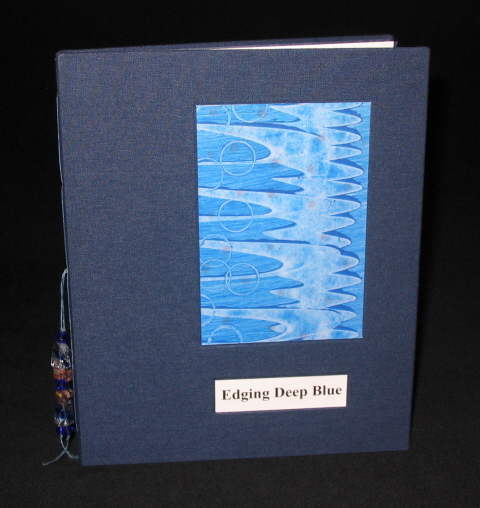
Immediately after the residency I had no plans to write much poetry beyond the haiku, but the images and observations from the Pictured Rocks time remained so vivid that I eventually completed Edging Deep Blue, a hand-bound book with twelve poems and twenty-seven photographs. This book became an additional donation to the park, and here is one of the poems:
First Evening at Home Base, Grand Marais
August 28, 2006
My suitcase zipper strains against bulges
of thermal underwear, turtlenecks, wool socks
I was certain of needing in the Upper Peninsula’s
waxing autumn. On the drive to Grand Marais,
the park’s easternmost point, we have shed our jackets,
lowered car windows, commented on green leaves
not yet tinged with fallish hues. At our home base,
a former Coast Guard station (circa 1938), I store
my bounty in a bedroom closet one floor above
the bathroom–once–radio room where, in 1975,
a guardsman sent the last land-based message to
the doomed Edmund Fitzgerald. Years of hi-fi, then
CD rounds of Gordon Lightfoot’s song surge
to my throat, linger. For sixteen nights we will rest
not a tenth of a mile from Lake Superior, from harbor
lights, inner and outer, that have saved other sailors.
This first afternoon settles
into pale grays above
sand dunes, dune grasses, a forty-foot cottonwood
still in full leaf that define our kitchen’s northward
lakeside view. After dinner we stroll past
the park ranger’s residence, follow a sand path
abutting the jetty, read a sign about teens swept away
as they ventured too far on the storm-whipped breakwall.
We step onto it, saunter far toward its tip, sit with backs
against the concrete that holds us over Superior’s
gently lapping waves. As waning rays gather in the west
and slate gray pools in the east, the sky around us
glows pink, then explodes into neon coral that rims
and tinges charcoal, blue-gray, white altocumulus
clouds, billowing and spreading. Mercurochrome light
dances atop shimmering aqua of the placidly
undulant water. To the northwest, black silhouettes
of tree-lined islands stretch far along the horizon,
then slowly rise, shift, disperse: our first mirage.
No cameras, no sketchbooks in hand, we stay fixed
until night has claimed all colors, unveiled the stars.
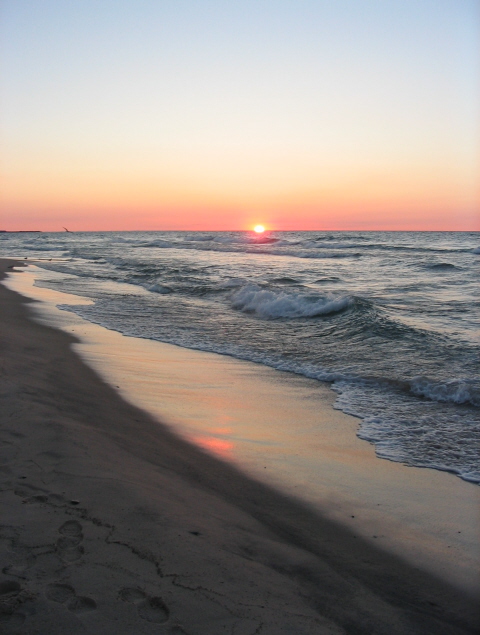

Glass, Books, Poems
While completing a two-month Penland concentration in book- and papermaking, I spent much of my free time visiting other studios and watching other artisans at work. My favorite haunt was the hot-glass studio, where the intricate dance of each glassblowing team mesmerized me and I came to appreciate the organic, fluid nature of glass. One of the glass studio members, Karola Dischinger, had traveled from her Swiss home for this experience, and she and I quickly became friends. 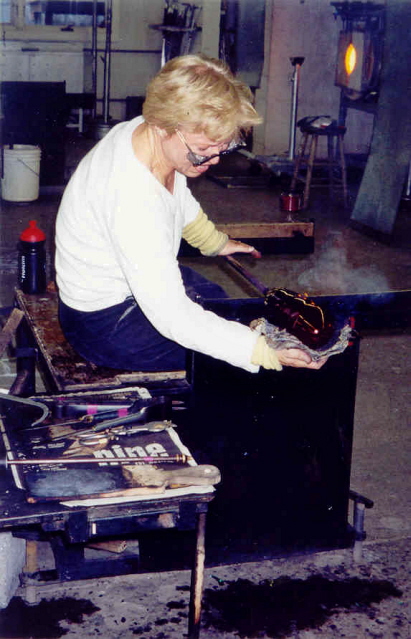 _That studio, like some of the others, had two instructors; in this case, the first, Hugh Jenkins, was to finish his teaching after the initial four weeks. Karola approached me on behalf of the glass studio members and asked whether I would make a large journal/album with blank pages, which the studio members could then fill, as a present to the instructor. Naively, I agreed . . . and the experience became one of the most memorable parts of my Penland stay.
_That studio, like some of the others, had two instructors; in this case, the first, Hugh Jenkins, was to finish his teaching after the initial four weeks. Karola approached me on behalf of the glass studio members and asked whether I would make a large journal/album with blank pages, which the studio members could then fill, as a present to the instructor. Naively, I agreed . . . and the experience became one of the most memorable parts of my Penland stay.
I learned Coptic stitching by tackling this large project–with much help from Julie Leonard, my books instructor! The journal’s cover featured Mexican bark paper and studio members’ glass pieces (murrine). I had the great pleasure of seeing the pages after they’d been filled with writings and drawings. In the exuberance of getting the book done just in time, I failed to take good photos of the finished journal/album, but I do have a snapshot. 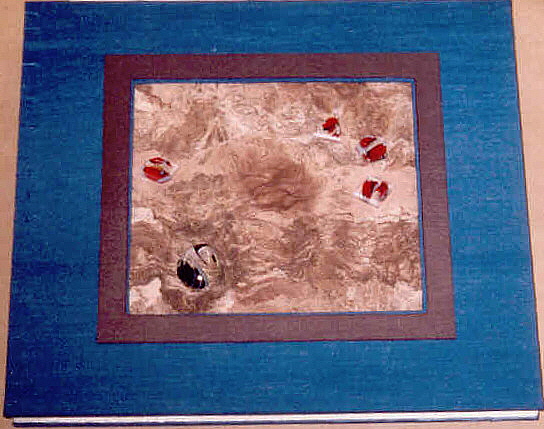 The studio members, in turn, gave me an overwhelmingly generous surprise: a newly made glass piece from almost every person, including the instructor and his son and studio assistant, Evan. And Karola gave me a whole group of her creations!
The studio members, in turn, gave me an overwhelmingly generous surprise: a newly made glass piece from almost every person, including the instructor and his son and studio assistant, Evan. And Karola gave me a whole group of her creations!
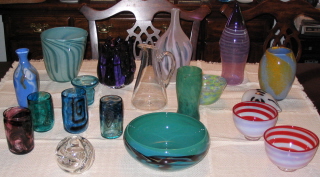
After the concentration ended, I wanted to use several small tree branches around which I’d wrapped some of my handmade flax paper while it was still wet. The resulting sculpted branches evoked a certain melancholy, so I pondered that feeling for a while and then found an excerpt from Thoreau’s Walden that relates to winter. That page exactly fit the mood I was seeking, and I found the perfect container for both the page and my sculpted paper: one of Karola’s hand-blown vessels. 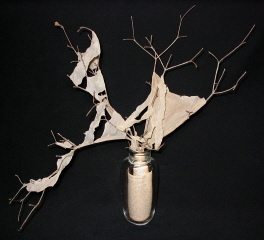 Another opportunity to link my bookmaking to Karola’s talents came when Karola sent me several beautiful, intriguingly shaped pieces she’d made, with the suggestion that I try those on book covers. The first one I chose became the centerpiece of the cover for a large journal/album for Karola.
Another opportunity to link my bookmaking to Karola’s talents came when Karola sent me several beautiful, intriguingly shaped pieces she’d made, with the suggestion that I try those on book covers. The first one I chose became the centerpiece of the cover for a large journal/album for Karola.
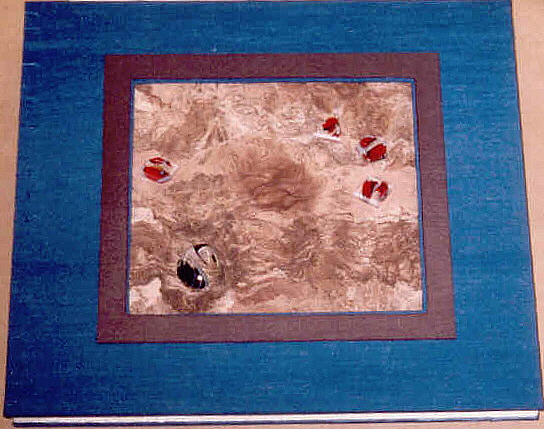
Karola and I have stayed in touch, and in 2016 we had our first reunion since the Penland concentration, when she attended a Glass Art Society conference in Corning, NY. During our visit, I learned even more about my friend’s generosity and creativity. Special congratulations to Karola on having been chosen as the glass artist representing Switzerland at the 2016 European Glass Context Exhibition and on her recent increase in international recognition! Of particular note is her January 4 through February 25, 2018, exhibition at Galerie Katapult, in Basel, Switzerland. In this major exhibition, titled "Modern Times--in Our Working Environment," Karola explores current workplace pressures and issues through a fascinating, wide-ranging collection of her glass creations. Her visionary artistry is remarkable!
My fascination with glass has kept growing, and I’ve written many poems that deal in some way with the history, lore, and mundane but miraculous properties of this substance. Actually, some of the poems have ended up being “non-glass” ones, such as . . .
Fairytale Revisited
Glass Slipper (of Cinderella). A curious blunder of the translator, who has mistaken vair (sable) for verre (glass).
—from Brewer’s Dictionary of Phrase and Fable
Reading that tale of cinder-salvaged
hopes, we could play a game—
Animal, Vegetable, Mineral?—to see
whether the vehicle for the perfect
match mattered. The fairy godmother
must have known something
the translator didn’t. Sable, rich
black or dark brown, would have
conveyed a creature comfort
to those cold, dainty extremeties
and instantly signaled the royals
that the radiant waif suited
their class, the only wearers
of this regal weasel’s silken fur.
How much quieter the ballroom
with animals against minerals:
Handsome Prince and Cinderella
gliding on pelts over polished stones,
warming to skin-on-skin pleasure.
Otherwise, what clatter. Heels
vanquishing melodies. Broken soles
drawing blood if he’d raised her
high but not properly slowed the
descent of mineral onto mineral.
Or blisters. Her poor flesh after
hours of obedience to unyielding
form (healed by some medicinal
vegetable concoction, perhaps).
In the original, a different focus.
Fates resting not on reflective
surfaces but on animal essences
acknowledged happily ever after.
With thanks to Pembroke Magazine, where this was first published.

Over time, more tales will be added, so please check back . . .